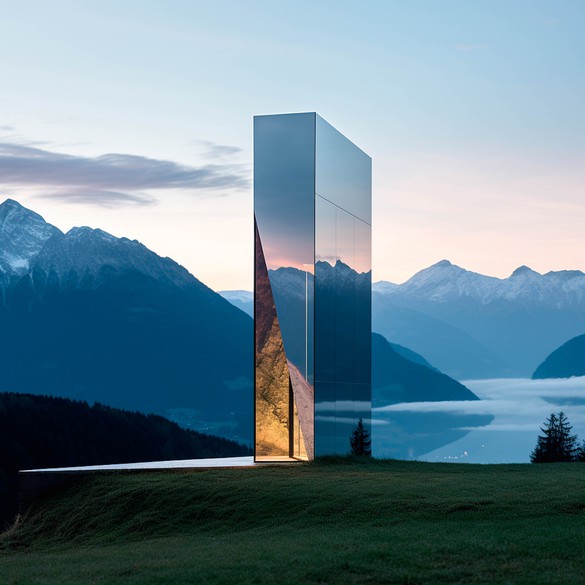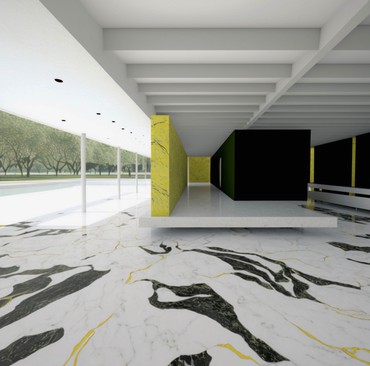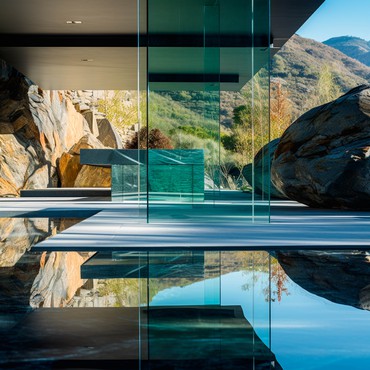
Neil Leach is an architect and professor and the author of over forty books, most recently addressing AI. He has taught at many of the leading schools of architecture in the world, including Harvard Graduate School of Design, Columbia Graduate School of Architecture, Planning and Preservation, the Southern California Institute of Architecture, and the Institute for Advanced Architecture of Catalonia, and currently directs the Doctor of Design program at Florida International University.

Ashley Overbeek is the director of strategic initiatives at Gagosian, where she has the pleasure of working with artists on Web3 and digital projects. Overbeek is also an advisory-board member of the Art and Antiquities Blockchain Consortium, a 501c3 nonprofit, and a guest speaker on the subject of art and blockchain technology at Stanford and Columbia University.
Ashley OverbeekYou’re publishing two books on AI and its impact on the field of architecture: Architecture in the Age of Artificial Intelligence, which you call “a celebration of the positive contributions of AI,” and The Death of the Architect, a more cautionary tale of the “dark side of AI” that outlines the risks AI poses to “unemployment, surveillance, and the loss of personal freedom.” How do you balance the utopian and dystopian visions of this technology?
Neil LeachIn a nutshell, I would say that I find AI amazing, but terrifyingly amazing. And I think about these two volumes, one white, one black, a bit like the yin/yang symbol: each contains a bit of each other in some sense. I think the dark side comes out of the light side. AI has amazing potential—after all, ChatGPT already knows 10,000 times what any human knows, and AI will soon be a billion times smarter than us. But that itself is a little scary.
Also, with any tool, much depends on who uses it and for what. You can use a kitchen knife to slice up vegetables or to murder someone. But when tools become autonomous, they become even more scary: [Berkeley computer-science professor] Stuart Russell produced a movie called Slaughterbots [2017] that shows how autonomous drones could be incredibly dangerous by using AI to identify, select, and kill human targets without human intervention.
AOWhat about AI in the hands of artists and architects?
NLI’m not sure that I’m qualified to talk about artists, but architects such as Zaha Hadid Architects are currently using AI to brainstorm possibilities at the beginning of a project and to come up with a far greater range of potential options than they could otherwise have imagined. Of course, at the moment AI is only generating 2D images, but new AI software is currently under development that will radically transform the entire design process. In two to three years time, we’ll be operating in 3D on a single platform, with all constraints—building codes, cost, structural performance, and so on—built into the system, so that design itself will effectively become automated. This will make design so much easier. Eventually AI might be able to design a building completely autonomously. But there’s a dark side to this too: once we have self-driving cars, we might not need drivers, and once AI is able to design a building by itself, perhaps we won’t need architects anymore.
AOYou argue that AI is a prosthetic that augments humans to become superhuman. How can we think about this blend of human- and machine-created design?
NLMario Klingemann, a pioneering German AI artist, uses the analogy of a piano player: when a song is played, you don’t say that the piano is responsible, you say the pianist or the composer is responsible. Klingemann uses a computer the way someone uses a piano, but instead of striking the keyboard to make music, he strikes his keyboard to make code. In the end, the author is a person who uses a machine.
On a related note, on the topic of copyright; AI doesn’t copy. The architectural historian Mario Carpo recently published an essay called “Imitation Games” [Artforum, Summer 2023] on the subject, claiming that AI is all about imitation. But he got it wrong: AI absolutely doesn’t copy. It searches and synthesizes images in often highly novel and unpredictable ways.
I’ll give you a personal example. I once was doing a design exercise based on Mies van der Rohe’s Barcelona Pavilion [1929]. I generated, maybe, I don’t know, 10,000 outcomes. None of them were the same. None at all. The AI application I was using, Midjourney, treated the building like some kind of language-of-shape grammar that could be transformed into any number of different permutations, but it never replicated the original building.
Now humans copy. This is fundamental to how we operate, as people like Theodor Adorno have recognized: “A human only becomes human at all by imitating other human beings.” It’s how culture catches on. You see someone wearing the latest fashion and you start wearing the same. You pick up expressions, tunes, and so on—that’s how culture propagates, through mimicry. So it’s endemic anyway. I think it becomes very murky in any case when it comes to the world of art, because where do you draw the line between collage, where you’re allowed to lift elements from others, and an original artwork itself? Copyright law is a little vague on these issues. The only really obvious contravention of copyright law would be if these companies were to scrape information or data from the Internet that’s copyright protected.
AOIt sounds like the decisions made are ultimately human but the number of choices that a human can make are broadened with AI, like your 10,000 outcomes generated from Mies’s Barcelona Pavilion.
AI serves to expand the range of possibilities of what we can imagine so that it becomes a prosthesis to the imagination.
Neil Leach
NLExactly. I wrote in my book about what’s called a GAN, a Generative Adversarial Network, which before these diffusion models was the best method for using AI to generate images. And what’s interesting about a GAN is it’s made up of these two neural networks competing against one another. One is a generator churning out stuff, right? Then one is the discriminator saying, “That’s not good enough, that’s not good enough, that’s not good enough.” You can think of it a bit like the generator is someone producing fake art, a fake Van Gogh for example, and the discriminator’s a bit like the critic saying “No, that’s not a Van Gogh, that’s not a Van Gogh.” In the process, the discriminator trains the generator to improve. And it’s actually quite similar to the model of how we humans operate: creative people need feedback, criticism, to improve their work.
Now obviously diffusion models, such as DALL·E and Midjourney, have now replaced GANs and operate in a fundamentally different way. They’re massive pretrained generic models and generate outcomes based on verbal “prompts.” And they’re much better than GANs. They’re quicker than GANs, generate better outcomes, and require no advanced technological understanding on the part of the user. But nonetheless the model of the GAN still helps to explain what’s happening when we use diffusion models to generate images: AI effectively becomes the generator and we take on the role of the discriminator.
Human beings are very, very good discriminators. You sniff a perfume, you can immediately say “I like that.” You sip a cocktail, you immediately know if it tastes good or not. You see a painting, immediately you can judge it. But although we like to think we’re good at generating new ideas, we’ve actually got a relatively limited range of imagination. AI serves to expand the range of possibilities of what we can imagine so that it becomes a prosthesis to the imagination. And what’s happening now is that AI is enhancing our ability to imagine and create.
AOSo does that mean that it’s a shift away from human creativity and more into human curation? And does the creativity now lie within the machine?
NLWhat’s interesting is that you need to be a good designer to use Midjourney effectively to create good designs, because you’ve got to have a “good eye” to pick the best option out of all the outcomes the program will produce. It’s generating options but you’re the final discriminator. So what AI is doing is shifting the nature of production itself: instead of producing designs all on our own, we now become the curator, the discriminator, the critic evaluating outcomes generated by AI. It’s like with a camera: in the old days we would carefully set up the perfect shot, but now we take a range of sample shots, select the best, and then edit and enhance it.
The question of creativity is a really interesting one. ChatGPT and Midjourney are based on pretrained neural networks called Large Language Models. Now these work incredibly well, but we don’t know quite why they work so well. They appear to have developed somewhat mysterious “emergent capabilities.” By this I mean they’ve taught themselves to write, translate, generate code, and—I would maintain—design without being specifically trained to do so. Again, this is amazing but also somewhat terrifying. In fact, the historian Yuval Harari observes that AI has now hacked our human operating system: language. And once you control language, you control everything. I would go further and claim that they’ve also hacked our visual operating system: art and design. Just look at these AI-generated images. I didn’t specify any detail in the prompt beyond a term like “house,” but AI generated the whole composition all on its own. Effectively, it designed everything. And that I find astonishing.
Now, if you think frankly about what these machines are doing, they’re just operating efficiently as machines and coming up with a range of options. That’s very much a mechanical task in some sense, and maybe what we call creativity—which, again, we don’t all fully align on a universal definition—is a bit like magic. Of course, magic doesn’t technically exist. A magician simply does a “trick,” concealing the operations at work, so as to dupe the audience into thinking that it’s magic. Now Arthur C. Clarke is reputed to have said that magic is simply whatever science has not explained yet. So perhaps these mysterious skills—these “emergent capabilities”—that AI has developed are simply the result of a process that science has not explained yet. In other words, magic is not magical, and creativity is not magical. We just use this vague term, “creative,” because we don’t actually understand what’s happening. And I would say what we call “creative” in this sense is simply a logical process in searching out the best solution.
AOSo does this critique of AI creativity also relate to human creativity?
NLYes. I think actually what makes AI interesting in many ways is it becomes a mirror in which we can understand ourselves. And that I think is one of the issues coming out, the whole question of, Are we really so creative?
Neural networks are one way to train an AI model, and they’re loosely modeled on the way our brains work. Loosely. But every now and again, these processes give us a sense of how we operate. So if we take the ChatGPT example, of the GPT model just predicting the next word, and out of that, out of that simple process, predicting the next word, for everything else that comes after—if its process is so straightforward, then maybe the human composition of sentences is more straightforward than we ever thought? And might the same principle also apply to images? Might we generate images in a manner not so dissimilar from how Midjourney generates images? So AI processes become an interesting mirror in which we can see both similarities and differences between ourselves and AI.
AOIn what other ways is the philosophical conversation around AI evolving?
NLI think we need to step back and realize that actually not only is AI different from human intelligence, it’s also superior. And I think our real problem up until now is that we’ve been taking a human-centered view on developments in AI, saying, well, it can’t do what we can do, it has no consciousness, it can’t do this, it hasn’t done that, and so on. I think we need to change our approach and think about what AI can do that we can’t do. That’s why in some of my writing and my lectures I talk about the second Copernican revolution. In other words, we need to stop thinking we’re the center of intelligence in the universe and recognize that there’s something out there that’s much smarter than us; and realize that, you know, really we have our limitations.

















